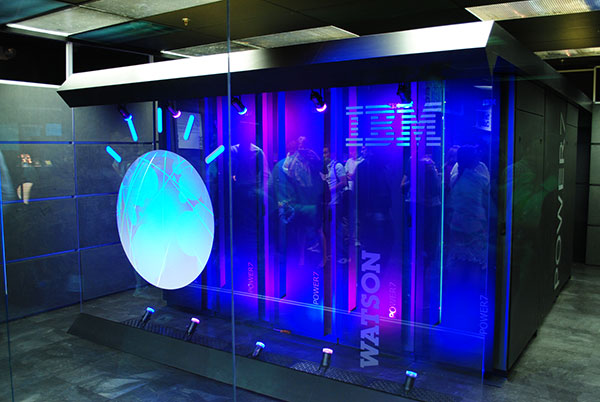It’s impossible to read any IT news in 2024 without seeing AI mentioned. The marketing departments of cloud providers, PC manufacturers, chip makers and software vendors seem to be obsessed with AI. In this article we ask if AI is actually such a big deal? And if it is, what does means for the IT channel?
The history of AI
Our synopsis of the history of AI would start in 1950 when Alan Turing proposed the Turing Test, as he foresaw the day when computerised intelligence could be indistinguishable from human intelligence.1 Over the next 30 years the mechanics of how these systems could work were hammered out. During the 1980s, the fundamental approaches were fleshed out including the back propagation method that is used by all large language model (LLM) AI systems today.2

It took until the late 1990s for IBM to demonstrate AI in the real world using its supercomputer mainframes. Deep Blue beat the World Chess Champion Gary Kasparov in 1997 and in 2011, IBM’s Watson system won the Jeopardy show in the USA.
In the last ten years, the power of the public cloud computing infrastructure has provided the brainpower, and the massive information available on the internet has provided the knowledge needed to train LLM systems, enabling companies to make significant progress. Open AI was founded in 2015 and in just nine years has grown to be the leader in the field. Microsoft invested $1bn in the company in 2019 and is benefitting from the integration of Open AI technology in the form of Microsoft Copilot across its solutions.
Is AI really such a big deal?
Of course, as IT professionals, we are bound to be caught up in the maelstrom of AI marketing from the large vendors in the industry. With global issues like war, disease, famine and refugees also in the headlines, is AI is it really a threat (or opportunity) on the same scale?
Looking for evidence outside the IT village, we studied the World Economic Forum (WEF) Global Risks Survey 2024. As an organisation whose goal is to improve the state of the world, is AI even on their radar?
The WEF is as concerned if not more concerned over deep fakes and misinformation than war
The forum was asked which five risks were most likely to present a material crisis in 2024 and over half their members said AI-generated misinformation, placing it in second place behind severe weather. The largest increase in rankings of threats were for technical power, concentration, and misinformation and disinformation, which jumped above armed conflict. The WEF is as concerned if not more concerned over deep fakes and misinformation than war.3
Licensed under Creative Commons BY-NC-ND 4.0
It’s fair to say that the IT community’s excitement over AI is not misplaced, the potential benefits and risks appear to be very real and are expected to accelerate through 2024.
With AI accelerating so fast what are the impacts on our business and social world?
Sustainability
AI is being used to try and solve some of our climate issues
We know that data centres are major electricity users and right now are the biggest hurdle for the public cloud companies to overcome to meet their net zero targets. There is a predicted increase in data centre capacity as a direct result of AI that will have a carbon impact. On the positive side, AI is being used to try and solve some of our climate issues, including modelling weather patterns and helping manufacturing organisations move to a more circular economy model.4,5,6,7
Security

Security is an area where cyber criminals are already harnessing the power of AI to deliver new types of attack. The WEF Global Cybersecurity Outlook report8 highlights a cyberattack where criminals gained access to a corporate network using social engineering; that is common, but in this case the criminals combined social engineering with deep fake text and voice messages. When you can receive voice and video messages from friends and colleagues, which appear genuine but are actually fake, keeping safe online is very difficult for individuals, corporations and even countries.
One situation called out by the WEF is a growing divide between large companies that are increasingly cyber resilient, and smaller companies that are falling behind in their cybersecurity readiness. The number of smaller companies who are under-prepared has jumped from 5% to 37% over the last two years. This is an area where the SMB and mid-market customers of MSPs will need help and support like never before in the coming months and years.
Jobs
A lot of focus around AI is on the impact it will have on the jobs market. The impact will not be felt evenly – a few jobs that will be replaced, many will be augmented, and some will be unaffected.9,10
Jobs most likely to be impacted include clerical and telemarketing
For the people who are replaced at work it won’t be by AI – it will be by another person who is more skilled in using AI and can be more productive in that role.
Jobs most likely to be impacted include clerical and telemarketing. Jobs least likely to be impacted include teaching and career guidance, clergy and healthcare workers.
The departments most likely to be hit are IT, finance, sales and operations.
AI impact on the IT channel
When it comes to the channel, there will be two ways that you can use AI, and we suggest that you start to explore both.
The IT channel is being customer- driven on AI rather than being proactive
For customer-facing AI, channel firms are already using the technology in areas such as data analytics, customer support, sales, and marketing. For internal use, most channel providers are still in the research and experimental stages 11. A recent report from CompTIA indicates that the IT channel is being customer- driven on AI rather than being proactive.
To get an idea where large organisations are using AI and the results they are seeing, we recommend the World Economic Forum Global Lighthouse Network12, where many of the world’s largest manufacturers are publishing the results of their leading edge IT projects, including 200 that make use of AI. The increase in throughput for process optimisation of between 40 and 140% is an area where even non-manufacturing customers could take some lessons in making their businesses more efficient using AI.
AI considerations for the IT channel
Vendor selection
- AI will have a significant impact on your organisation and customer relationships with deep access to your critical data. Ensure you partner with an AI supplier you trust and one that has solutions your customers are likely to deploy.
Data privacy and security
- Consider what data you allow an AI model to access and what happens to it.
AI impact on cybersecurity
- AI is already disrupting the cybersecurity market and as protecting customers from online threats is a key role of the IT channel, service providers will need to keep pace with AI developments and how they are impacting security.
Mitigating AI accuracy issues
- AI models will produce some anomalous results, how will you spot these and correct them?
Legal compliance and regulations
- Consider the legal implications around data privacy and access for your organisation and your customers who may also have specific industry regulation to comply with.
Integrating AI with existing systems
- Will you sandbox your AI initiative of integrate it fully with existing systems?
Staff acceptance and training
- Staff will need education on AI and any fears overcome.
Cost benefit and return on investment
- Weigh up the ROI of an AI project carefully including any potential risks.
AI Impact on the cloud Market

The reliance on the public cloud network to develop and deliver AI is having impacts already. Microsoft has been closing the market share gap to AWS for years. Microsoft’s compelling end to end story around cloud, including Copilot AI, has helped the market share gap close drastically in the last few quarters, with the potential to draw level and even overtake AWS as the leading cloud platform in the next year or two.13
Synergy Research Group (SRG) is predicting that AI will have a near exponential effect on the need for more data centre capacity with the hyperscalers looking to almost triple capacity in the next six years. Unconfirmed reports that Microsoft and OpenAI are planning a $100bn AI computer in the next five years lend some credibility to the SRG report.14,15,16
The LLM / generative AI market
From a commercial perspective, the clear leader right now is Microsoft
In terms of models, GPT-4 is the market leader with its Microsoft integration, Google Gemini and Amazon Olympus are receiving huge investment to catch up. These are the dominant players, along with specialist Anthropic. Apple seems wedded to the concept of AI in devices rather than the cloud, so no clear LLM strategy is evident right now. Samsung is developing a generative AI solution called Gauus and we expect more vendors to follow suit. IBM relinquished its early lead in AI but remains one of the largest investors in quantum computing, and when the technology matures, that could be the trigger for that sees the company gaining traction in the AI space.
From a commercial perspective, the clear leader right now is Microsoft. With the majority of customers running some form of Microsoft Office, server and cloud solutions, its availability across the portfolio and the continuous updates Microsoft provides for Copilot, make this a no-brainer investment area for channel partners.
Channel actions
- Formalise a programme for continual AI education across the business.
- Identify a core internal and customer application for AI and start trials.
- Select a vendor with an ethical approach to AI such as the ‘AI for Good’ message that Microsoft uses within the Microsoft Partner Pledge.
- Be sensitive around marketing AI – focus on process improvement, not job replacement.
- Take small deliberate steps with continual learning and iteration.
- Lean on your distribution partner for education and resources.
- If you have customers using Microsoft, Copilot should be your go to solution for your initial foray into AI.
References
- Alan Turing Scrapbook - Turing Test
- Learning representations by back-propagating errors | Nature
- Global Risks Report 2024 | World Economic Forum (weforum.org)
- JLL-data-center-outlook-global-2024.pdf
- Harnessing AI and computing to advance climate modelling and prediction | Nature Climate Change
- Microsoft_Accelerating-Sustainability-with-AI-A-Playbook-1.pdf
- IT Is Improving the Circular Economy (gartner.com)
- WEF_Global_Cybersecurity_Outlook_2024.pdf (weforum.org)
- Chart: The Jobs Most Impacted by AI (visualcapitalist.com)
- Jobs of Tomorrow: Will AI automate or augment future work? | World Economic Forum (weforum.org)
- Comptia-it-industry-outlook-2024_final.pdf (comptiacdn.azureedge.net)
- Global Lighthouse Network: Adopting AI at Speed and Scale | World Economic Forum (weforum.org)
- Cloud Market Gets its Mojo Back; AI Helps Push Q4 Increase in Cloud Spending to New Highs | Synergy Research Group (srgresearch.com)
- Hyperscale Data Center Capacity to Almost Triple in Next Six Years, Driven by AI | Synergy Research Group (srgresearch.com)
- Hyperscale Data Centers Hit the Thousand Mark; Total Capacity is Doubling Every Four Years | Synergy Research Group
- Microsoft & OpenAI consider $100bn, 5GW 'Stargate' AI data center - report - DCD (datacenterdynamics.com)
